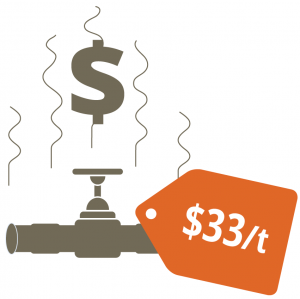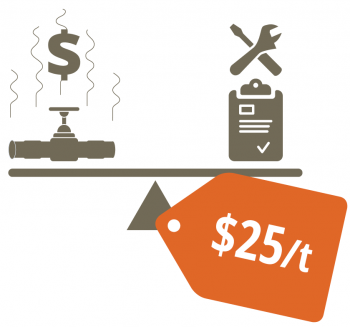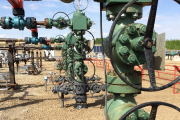There’s a lot of commotion around preventing methane (better known as natural gas) from leaking or being otherwise wasted in the oil and gas industry these days. There’s good reason for that: it’s the cheapest way to cut greenhouse gas emissions and methane is a more potent contributor to global warming than carbon dioxide. Despite this fact having been reiterated by government, industry, and environmental groups, some critics continue to say Canada’s proposed methane regulations are too costly when combined with provincial and federal carbon price proposals. The reality is, these methane regulations don’t yet combine with carbon pricing, although we believe that in order to reach Canada’s climate targets, all emissions need to be eventually covered under a carbon price, including methane.
What, no carbon price?
The methane emissions targeted by Canada’s draft oil and gas regulations will not have a carbon price applied to them immediately. The Pan-Canadian Framework on clean growth and climate change has committed Canada to applying carbon pricing to the same sources as British Columbia’s carbon tax — which currently applies to all fossil fuel use at oil and gas operations with recent commitments to broaden it to include fugitive (inadvertently leaked) methane as well. Alberta and Saskatchewan will have some catching up to do to meet an equivalent level, with Alberta’s carbon levy only partially applying to the oil and gas sector in 2023, and no plans for carbon pricing in Saskatchewan.
A carbon price on fuel use including flaring is especially important given the focus of Canada’s draft methane regulations, which are structured to shift the sector’s methane releases to flaring instead. Flaring is a process in which gas (predominantly methane but sometimes containing other gases) is disposed of through burning the gas and converting it into less harmful compounds. Flaring is a better option than venting due to the greater and faster impact methane has in the atmosphere compared to the carbon dioxide it is converted into through burning. However, with current levels of methane releases that fall under these regulations, a shift to methane flaring will still have a substantial climate contribution and implications for provincial flaring limits. A carbon price applied to flaring emissions can motivate the efficient use of fuel, and provides industry with incentive to shift towards conserving valuable natural gas rather than simply burning it off, which costs money. Progressive operators will be carefully evaluating how to minimize their future carbon costs — and a future carbon price should be an incentive for them to capture this resource.
So, why regulations?
Levying a price on combusted methane but not fugitive methane comes down to our current inability to accurately measure methane emissions. Our knowledge of most methane emissions from oil and gas sites is based solely on generic estimation methods that rely on poor equipment inventories that are not routinely updated. Without precise measurements, a carbon price can’t be legitimately applied.
Methane measurements won’t be inaccurate forever. Given the importance of reducing this potent gas to mitigate climate change, innovators in Canada have devised better ways to understand what is really happening at oil and gas sites. Industry has been slow to adopt these approaches, which is why Canada’s draft methane regulations are necessary to raise the bar and require the use of off-the-shelf technology to improve emissions management. As the data and information is collected under these new Canadian regulations, accuracy will improve and allow for the application of a carbon price in the future — as is being suggested in British Columbia.
What’s the cost?
Opinions differ on whether or not a carbon price is more effective than regulations. Let’s simply evaluate the different approaches suggested to reduce these emissions and give a rough estimate of their comparable cost to industry.
Economist preferred! Apply a carbon price
 Supported by most economists, this allows for flexibility in the approach selected to reduce emissions, the expectation being that operators pursue the lowest-cost solutions. Over 20 years (the period over which methane has the greatest impact) a carbon price would end up costing $96/tonne CO2e (100-yr) or $33/tonne CO2e (20-yr) if the oil and gas industry chooses to only make investments to meet the draft federal methane regulations to reduce emissions.
Supported by most economists, this allows for flexibility in the approach selected to reduce emissions, the expectation being that operators pursue the lowest-cost solutions. Over 20 years (the period over which methane has the greatest impact) a carbon price would end up costing $96/tonne CO2e (100-yr) or $33/tonne CO2e (20-yr) if the oil and gas industry chooses to only make investments to meet the draft federal methane regulations to reduce emissions.
Historically proven! Action through regulation
 This approach provides the highest certainty of reductions, dependent only on the certainty provided by the industrial compliance and enforcement system under which it is regulated. Over 20 years, this is estimated to cost $12/tonne CO2e (100-yr) or $4/tonne CO2e(20-yr).
This approach provides the highest certainty of reductions, dependent only on the certainty provided by the industrial compliance and enforcement system under which it is regulated. Over 20 years, this is estimated to cost $12/tonne CO2e (100-yr) or $4/tonne CO2e(20-yr).
Both! Regulations now, carbon price later
 By not applying a carbon price to the oil and gas sector’s methane emissions until they are more rigorously measured and reported in 2023, the sector will have a better chance of rounding up capital to install the equipment necessary to comply with regulations. The ultimate application of the carbon price in 2023 also provides additional incentive to go beyond the regulations and avoid future carbon costs. Over 20 years, this is estimated to cost $71/tonne CO2e (100-year) or $25/tonne CO2e (20-yr).
By not applying a carbon price to the oil and gas sector’s methane emissions until they are more rigorously measured and reported in 2023, the sector will have a better chance of rounding up capital to install the equipment necessary to comply with regulations. The ultimate application of the carbon price in 2023 also provides additional incentive to go beyond the regulations and avoid future carbon costs. Over 20 years, this is estimated to cost $71/tonne CO2e (100-year) or $25/tonne CO2e (20-yr).
In each case, it is assumed methane is reduced only by 45 per cent by 2025, aligning with the level of reductions expected from the federal methane regulations. It would be reasonable to expect applying a carbon price in both scenarios would drive reductions beyond those required, based on their cost effectiveness and the carbon pricing level of the day. As the carbon price follows the price schedule outlined by the Canadian government — reaching $50/tonne by 2022 — the logic is that industry would continue to reduce emissions that cost less than the carbon price.
We know we have to act to reduce the emission of this potent GHG and conserve Alberta’s natural gas resource. The only question is: what’s the best approach? A smart policy will evolve with changing data and technology, and facilitate hitting the interim target of a 45 per cent reduction by 2025 and the longer-term reality that the oil and gas industry needs to decarbonize.







